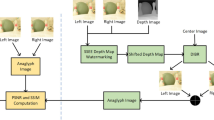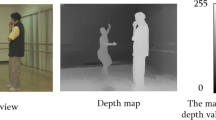Abstract
Compared with the wide research on reversible watermarking scheme for raster image, the research on its counterpart for 2-D CAD engineering graphics lags far behind. In this paper, based on improved quantization index modulation (IQIM) and improved difference expansion (IDE), a combined reversible watermarking scheme is proposed for 2-D CAD engineering graphics. The proposed scheme can solve the embedding-limitation problem existing in IQIM technique and increase the watermark embedding capacity greatly. Theoretical analysis and experimental results also show that the proposed scheme has good imperceptibility and robustness.



Similar content being viewed by others
References
Alattar AM (2004) Reversible watermark using the difference expansion of a generalized integer transform. IEEE Trans Image Process 13:1147–1156
Chaumont M, Puech W (2009) A high capacity reversible watermarking scheme. In: Proc. SPIE, Visual Communications and Image Processing. pp 72571H-9
Coltuc D, Chassery JM (2007) Very fast watermarking by reversible contrast mapping. IEEE Signal Proc Lett 14:255–258
Fridrich J, Goljan M, Du R (2001) Invertible authentication. In: Proc. SPIE, Security and Watermarking of Multimedia Contents. pp 197–208
Fridrich J, Goljan M, Du R (2001) Distortion-free data embedding for images. In: Proc. 4th Information Hiding Workshop. pp 27–41
Hong W, Chen TS, Chang YP, Shiu CW (2010) A high capacity reversible data hiding scheme using orthogonal projection and prediction error modification. Signal Process 90:2911–2922
Honsinger CW, Jones P, Rabbani M, Stoffel JC (2001) Lossless recovery of an original image containing embedded data, U.S. Patent 6278791
Ji HM, Yang XQ, Zhang CM, Gao XF (2010) A new reversible watermarking of 3D models based on ratio expansion. In: Proc. 2010 3rd International Congress on Image and Signal Processing (CISP). pp 3899–3903
Kwon KR, Jang BJ, Lee EJ, Huh Y (2004) Copyright protection of architectural CAD drawing using the multiple watermarking schemes. In: IEEE international conference on multimedia and expo. ICME. pp 871–874
Lee H, Dikici C, Lavoue G, Dupont F (2011) Joint reversible watermarking and progressive compression of 3D meshes. Vis Comput 27:781–792
Lee SH, Kwon KR (2010) CAD drawing watermarking scheme. Digit Signal Process 20:1379–1399
Peng F, Guo RS, Li CT, Long M (2010) A semi-fragile watermarking algorithm for authenticating 2D CAD engineering graphics based on log-polar translation. Comput Aided Des 42:1207–1216
Peng F, Lei YZ (2011) An effective reversible watermarking for 2D CAD engineering graphics based on improved QIM. Int J Digit Crime Forensic 3:53–69
Peng F, Lei YZ, Long M, Sun XM (2011) A reversible watermarking scheme for two-dimensional CAD engineering graphics based on improved difference expansion. Comput Aided Des 43:1018–1124
Tian J (2003) Reversible data embedding using a difference expansion. IEEE Trans Circ Syst Video Technol 13:890–896
Tsai P, Hu YC, Yeh HL (2009) Reversible image hiding scheme using predictive coding and histograme shifting. Signal Process 89:1129–1143
Voigt M, Yang B, Bush C (2004) Reversible watermarking of 2D-vector data. In: Proc. Multimedia and Security Workshop. pp 160–165
Wang XT, Shao CT, Xu XG, Niu XM (2007) Reversible data-hiding scheme for 2-d vector maps based on difference expansion. IEEE Trans Inf Forensic Secur 2:311–320
Wang C-T, Yu H-F (2012) High-capacity reversible data hiding based on multi-histogram modification. Multimed Tools Appl 61:299–319
Zhao H, Wang H, Khurram Khan M (2011) Statistical analysis of several reversible data hiding algorithms. Multimed Tools Appl 52:277–290
Zhu AP, Zhang CM, Yang XQ, Gao XF (2010) Reversible watermarking of 3D mesh models using prediction-error expansion. In: Proc. 2010 3rd International Congress on Image and Signal Processing (CISP). pp 1171–1175
Acknowledgment
The work was funded by the Natural Science Foundation Project of CQ CSTC (Grant No. 2011jjjq40001).
Author information
Authors and Affiliations
Corresponding author
Appendix
Appendix
In this part, we present the process to determine the values of t and k in detail as a supplement to Section 4.1.
Since we embed watermark in the relative distance r as described in step 2 of Section 3.1, we can calculate the range of the watermarked relative distance r w as follows.
According to the Eqs. (6) ~ (7), we get r = (I + F) × 2s × 10p, and according to the Eq. (10), we get r w = (I w + F) × 10p, then
Given w ∈ {0, 1, …, 2s − 1} and F ∈ [0,1), we obtain r w − r ∈ (1 − 2s, 2s − 1] × 10p. With r ∈ [0, 2b × Δ), we can get r w ∈ [(1 − 2s) × 10p, 2b Δ + (2s − 1) × 10p].
By substituting the range of r w into Eq. (24), we can obtain
Then, it follows that
To solve the above inequalities, two linear equations are firstly denoted as
We use a geometric method shown in Fig. 4 which considers the equation geometric meaning. To guarantee Inequality (33) solvable, the slope of Line t = f(g) must be smaller than that of Line t = f(k), that is \( \frac{1}{\varDelta -5\cdot {10}^{-\left(q+1\right)}}<\frac{1}{5\cdot {10}^{-\left(q+1\right)}} \), then we obtain the range which ∆ must satisfy is ∆ > 10-q.
Let f(k 0) = g(k 0), then we obtain X-coordinate of the intersection between the two lines
As seen in Fig. 4, when k is larger than k 0, any value of t within (t1, t2] can satisfy Inequality (33).
So finally we manage to obtain the range of the two parameters
where \( {k}_0=\frac{5\varDelta {2}^b\cdot {10}^{-\left(q+1\right)}+\left({2}^s-1\right)\varDelta \cdot {10}^p}{\varDelta -{10}^{-q}} \).
Therefore, as long as t and k meet the above condition, Inequality (33) can be satisfied. Then our watermark scheme will be reversible.
Rights and permissions
About this article
Cite this article
Xiao, D., Hu, S. & Zheng, H. A high capacity combined reversible watermarking scheme for 2-D CAD engineering graphics. Multimed Tools Appl 74, 2109–2126 (2015). https://doi.org/10.1007/s11042-013-1744-x
Published:
Issue Date:
DOI: https://doi.org/10.1007/s11042-013-1744-x





